Motorcycle enthusiasts who want to explore off the beaten path, with a friend or loved one, in comfort, will be well served by Kawasaki’s Teryx KRX 1000 ($23,199). This is Kawasaki’s non-street-legal, sport-oriented two-seat UTV. Contrary to a new motorcycle, where you have to have a certain level of physical skill, including balance and dexterity, these vehicles are more similar to driving a car. And there’s over 200 million licensed drivers in the United States. Vehicles like the Teryx open up a world of exploration for someone who wants to get outside.
Editor’s note: We test drove the ‘22 version of Kawasaki’s do-it-all sport UTV during the 2022 Kawasaki Teryx KRX 1000 Review article and video.
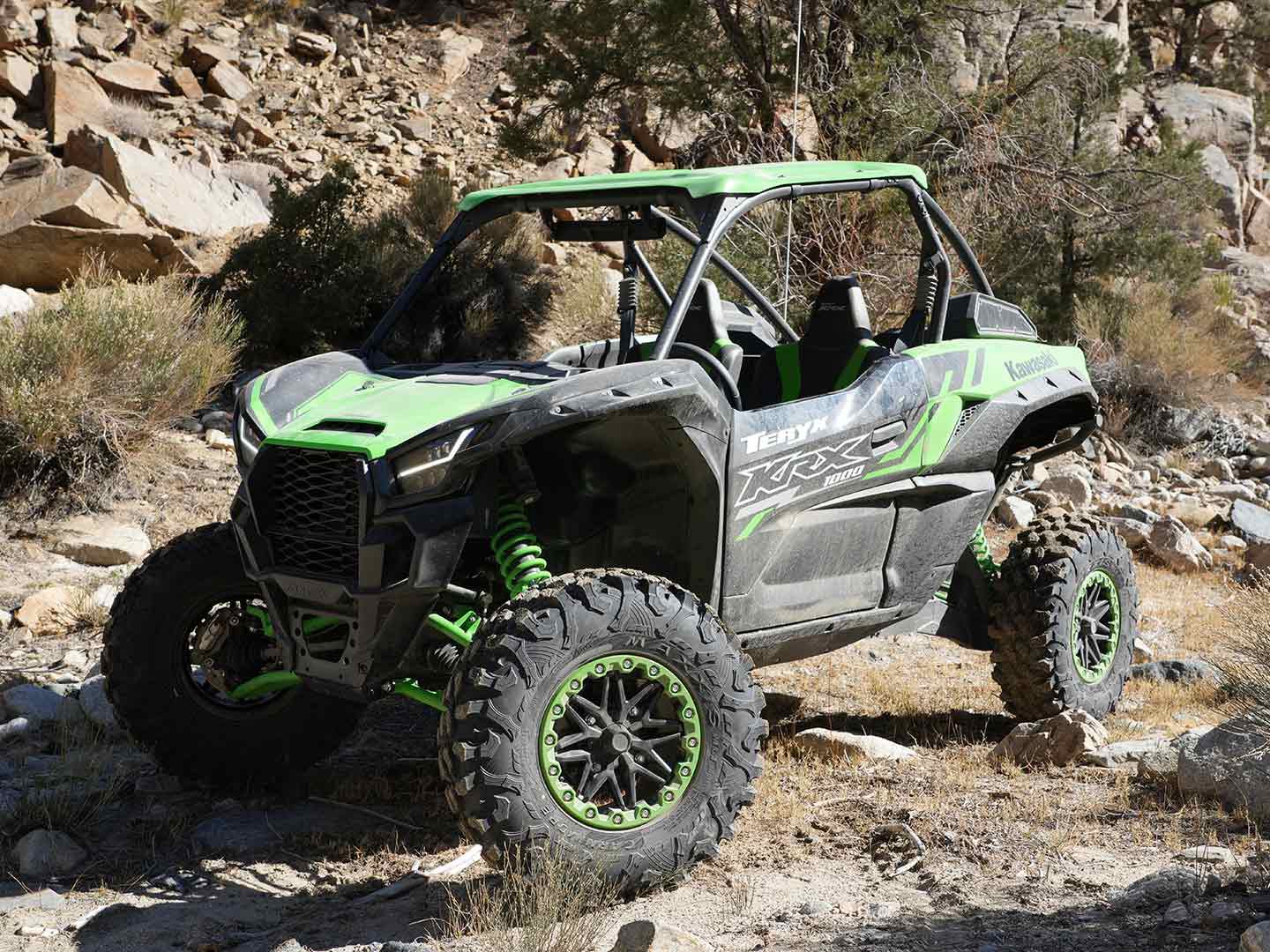
For the 2023 model year Kawasaki’s done a couple of subtle improvements to this Teryx KRX 1000: new steering wheel material, and improved floorboard design to evacuate the mud and rain more efficiently. It also includes ride-by-wire throttle. Plus, there’s a KRX4 four-seat model ($27,499), so more of your friends and family can participate in outdoor fun. The Teryx is powered by a heavy-duty 999cc parallel-twin engine. The engine case and transmission housing are noticeably beefier than a streetbike and was purposely engineered for the rigors of this nearly 1,900-pound vehicle. Oversize shocks with 21 inches of rearward suspension travel and 19 inches up front, with four wheel disc brakes (two-piston calipers up front, single-piston in the rears) and true four-wheel drive (with an electronically locking front differential) allow the KRX 1000 to climb serious terrain that Jeeps and other modified four-wheel-drive vehicles would be hard pressed to navigate.
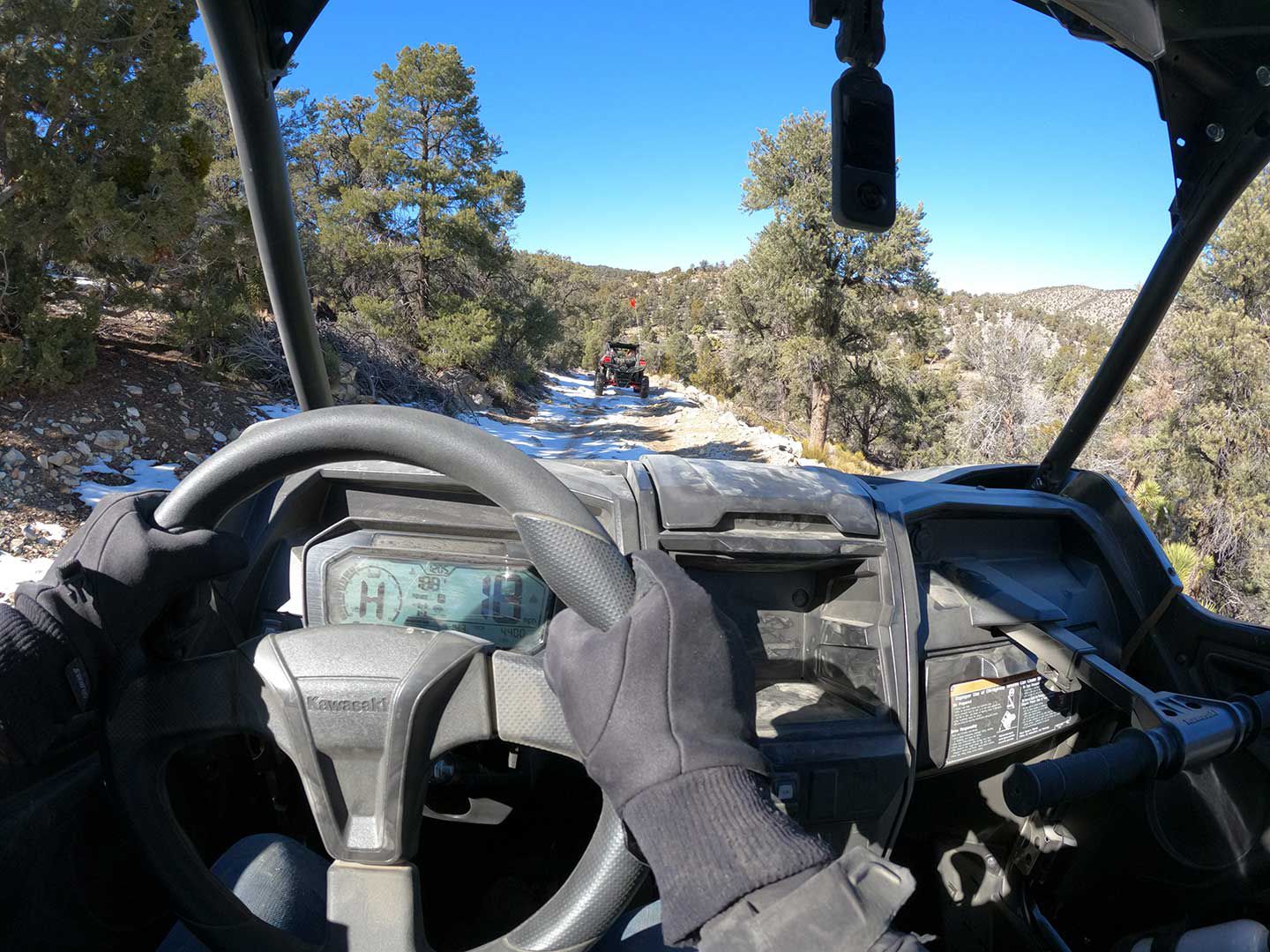
Electronic power steering provides support so you don’t have to be a strong human to turn the steering wheel. Sometimes electronic power steering offers a vague steering feel because there isn’t that classic feel-rich hydraulic mechanical connection. With Kawi’s setup, the steering feel is decent. If you’re an operator who lives and dies by handling feel, you’re not going to have a ton of feedback, but it’s not terrible either.
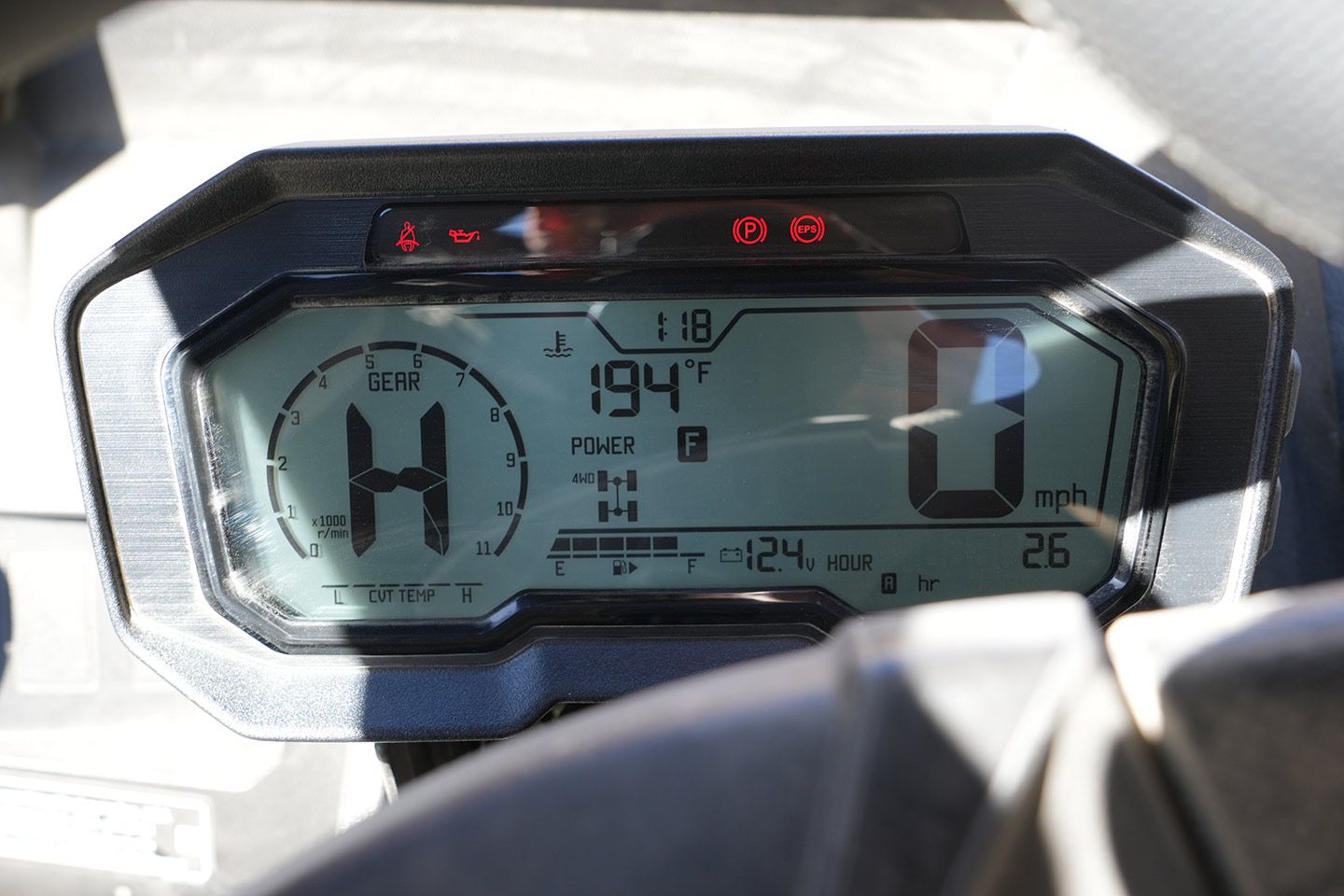
Speaking of steering, this vehicle is fairly maneuverable. It doesn’t take up a ton of real estate to turn around or do tight maneuvers in limited space (it has a 20.3-foot turning radius), which is nice. Again the electronic power steering just makes for a very light steering feel.
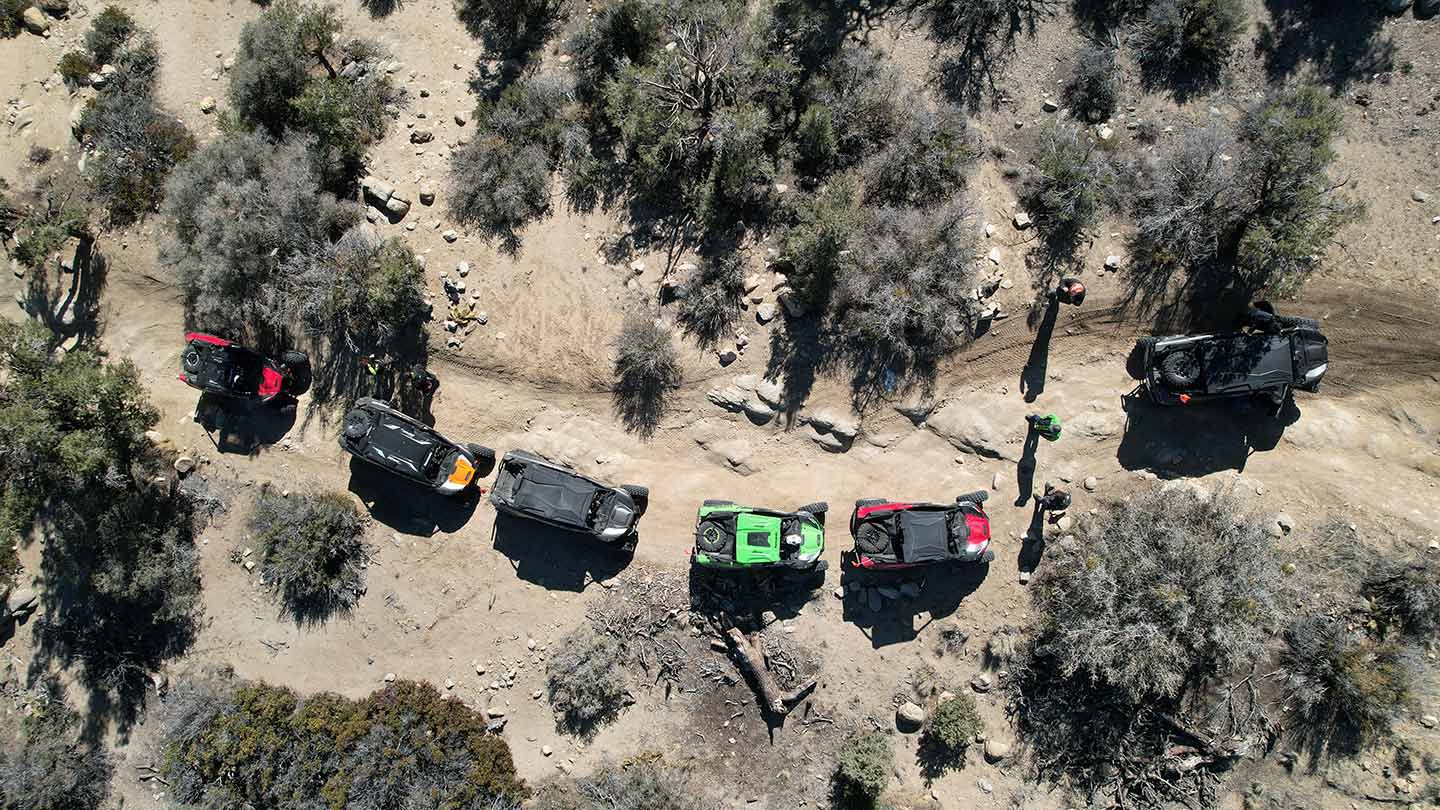
Hopping into the KRX is similar to getting into the seat of an automobile. Passenger-car-style doors have easy-to-use handles. A pair of bucket seats and a three-point safety belt secure the rider and passenger inside the vehicle. The doors are tall enough to keep your arms inside the cockpit (more on that later…). This vehicle employs a conventional steering wheel with tilt steering. So you can move the steering wheel up or down based on preference. We have the steering wheel in a lower setting. Adjustable seat position for both rider and passenger make for a roomy cockpit for tall and short operators alike. This cockpit does a good job of shielding the rider’s lower extremities from the elements. Plus it doesn’t kick off excessive engine heat like Polaris’ Slingshot.
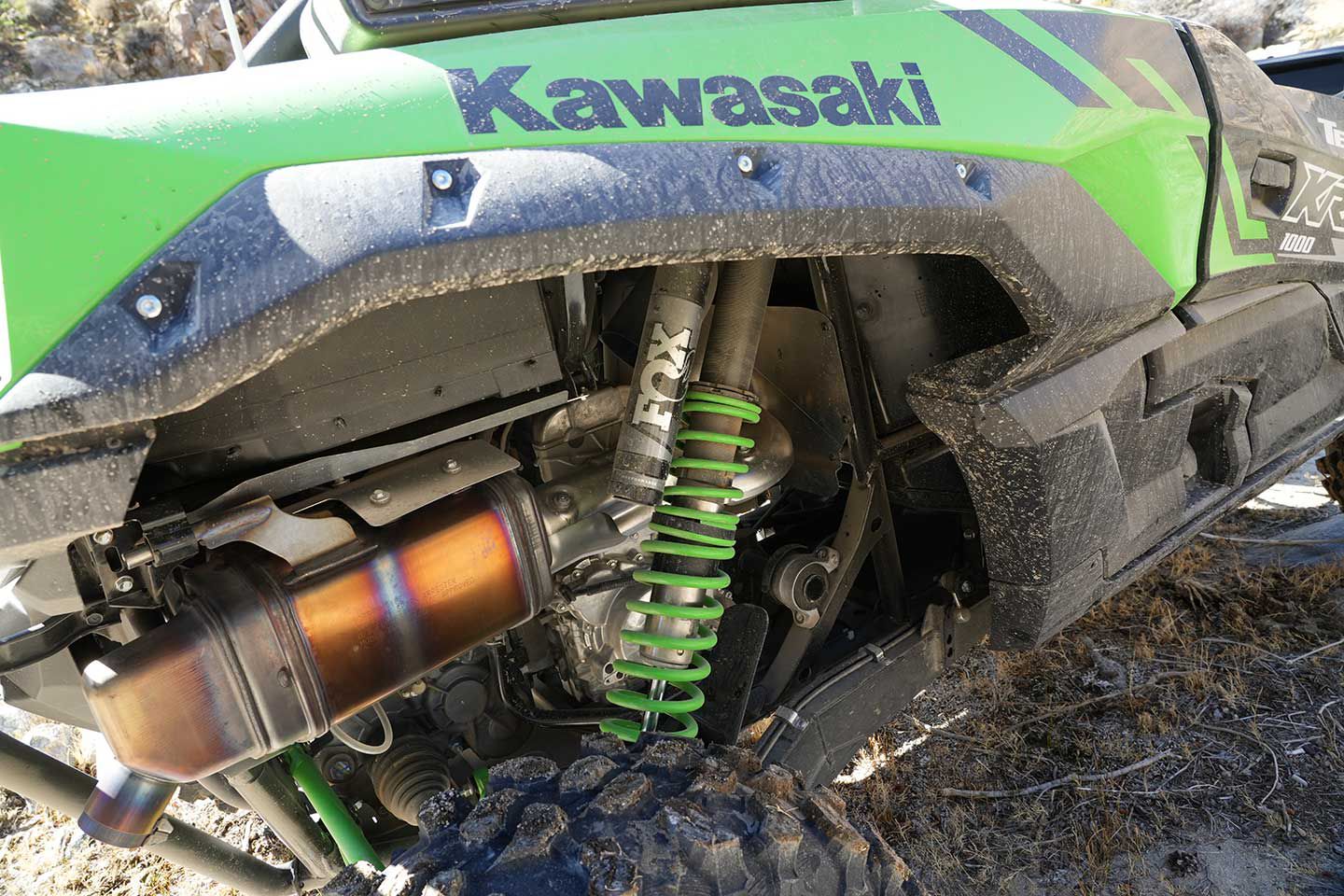
A mechanical shift lever allows the operator to select between drive modes (H, L, N, and R). “H” stands for high running gear and is the selection for forward propulsion at all vehicle speeds. Conversely “L” is low range and meant for traversing steep obstacles at low speeds. For instance, if you’re climbing a steep grade, rock crawling, going down a treacherous decline, or towing something heavy, you want to use L. The vehicle must be stopped to switch between drive modes. There’s also an “N” selection to roll the vehicle, without power, i.e., in the garage. Lastly, “R” is for reverse.
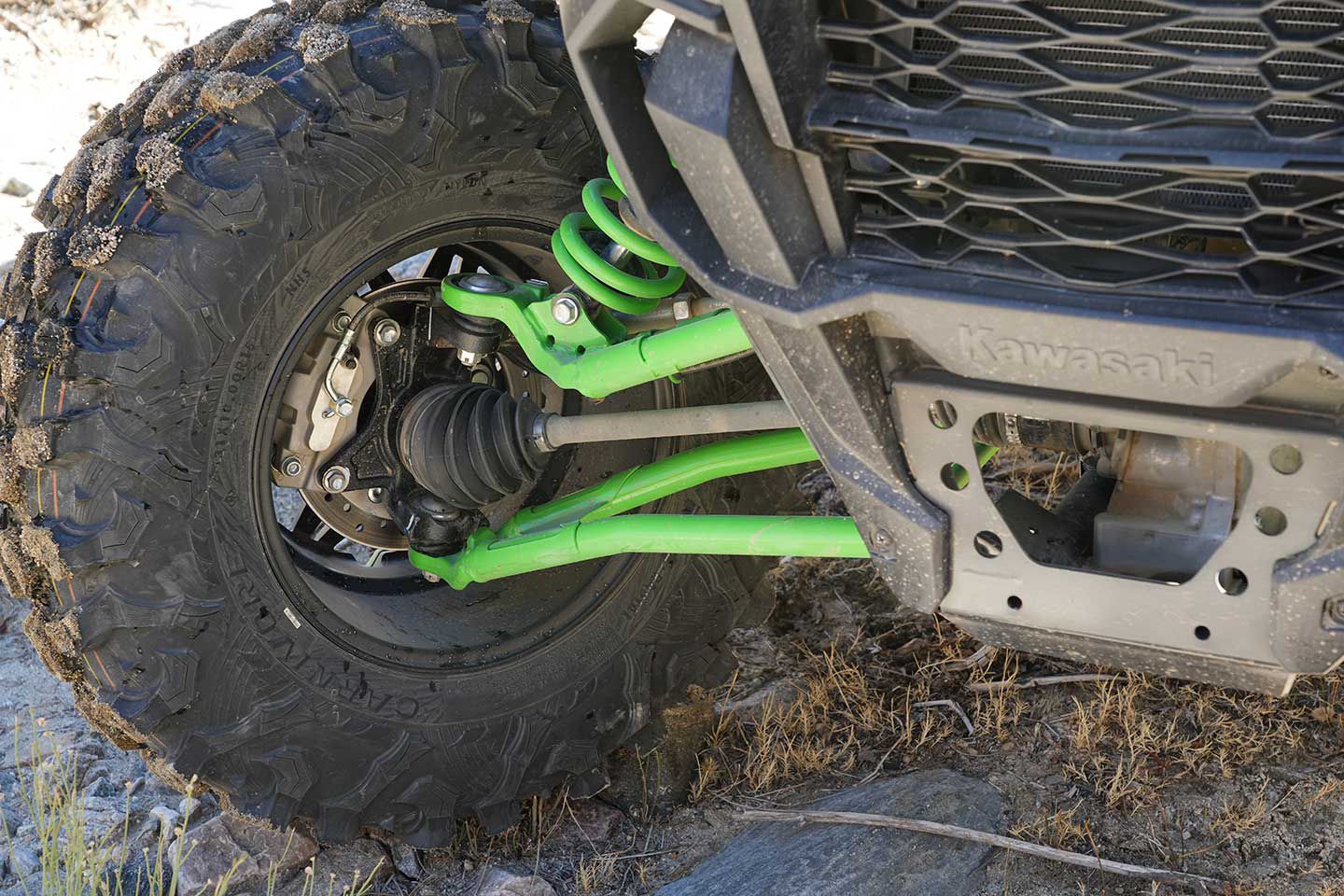
A nice wide mirror does a good job of showing us what is going on behind us. This particular KRX 1000 is not outfitted with Kawasaki’s slick color TFT display. That is an accessory and we would absolutely opt for it if this vehicle was ours. It’s touchscreen compatible, and has GPS navigation so you’re never lost. Depress the brake pedal and twist the automotive-style ignition key and away we go…
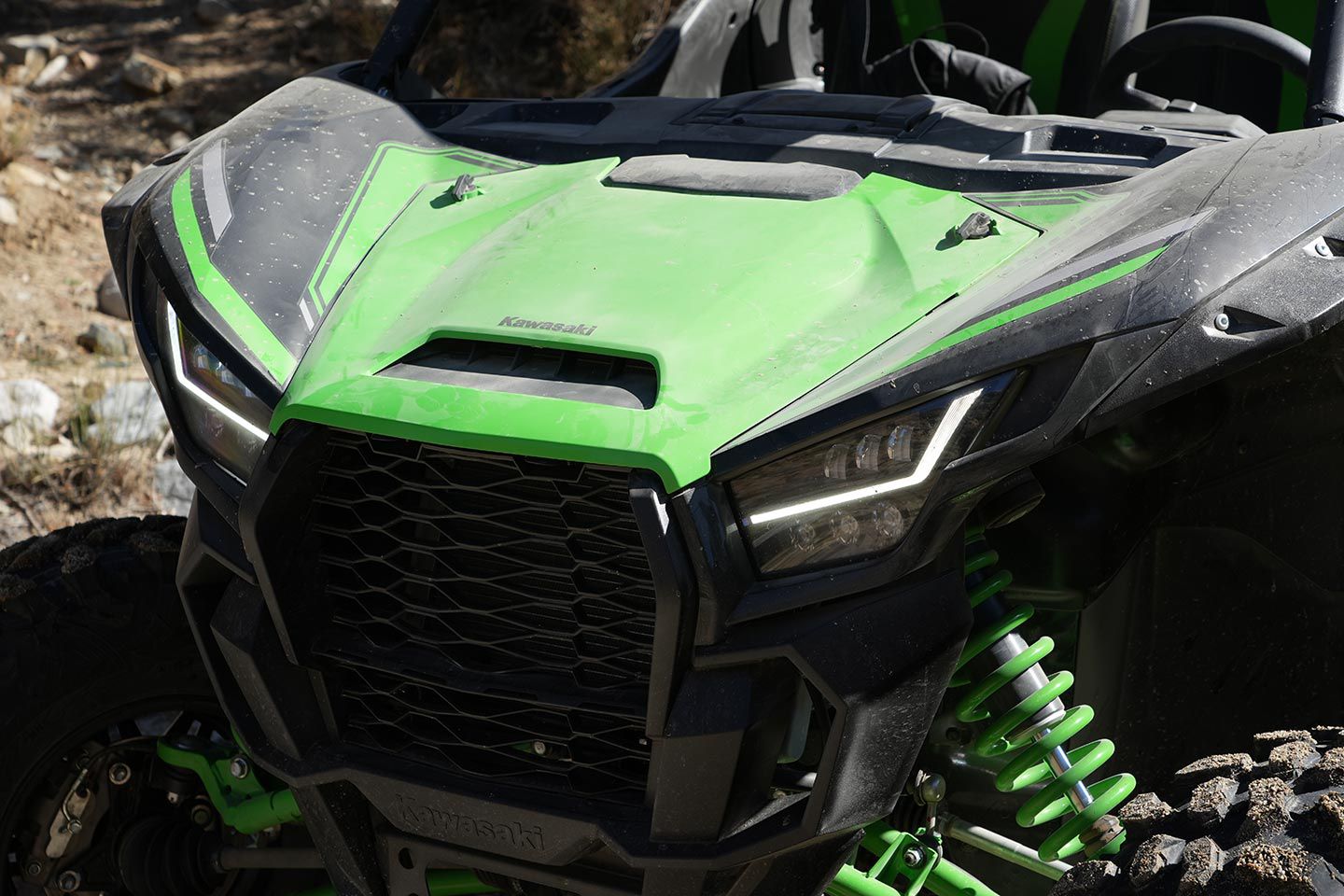
The Teryx KRX 1000 engine is water-cooled with dual overhead camshafts and an eight-valve cylinder head. Kawasaki rates this engine configuration at around 116 hp at the crank with approximately 77 lb.-ft. torque. So compared to other contemporary sport UTVs, this Teryx isn’t the fastest four-wheeler on the trail. But what it lacks in raw power, it makes up for in ease of use. Despite offering ride-by-wire throttle, throttle response is a tad muted and feels identical to the previous mechanical setup.
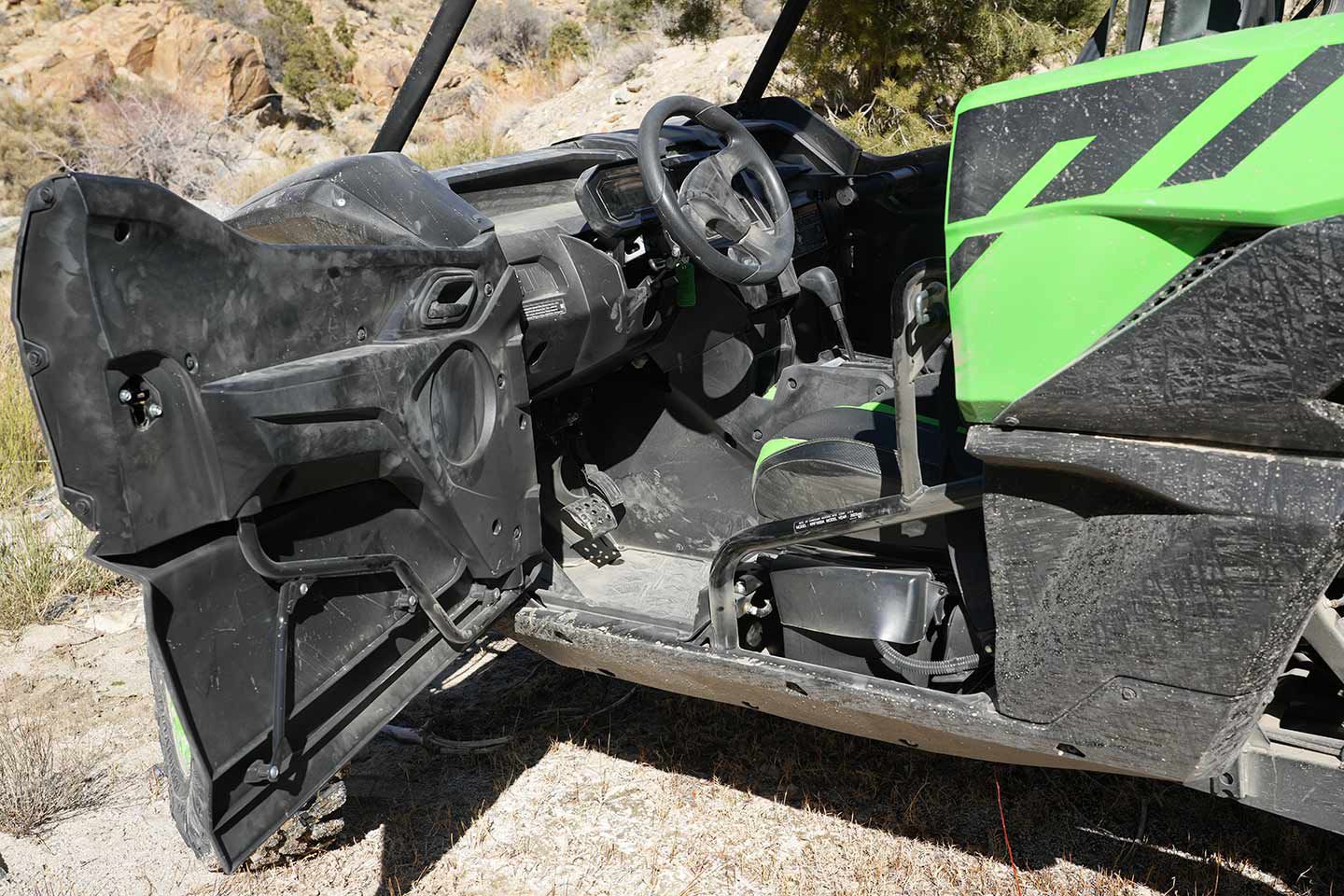
There’s also a high and low engine power mode. Full power gives you access to the claimed 116 ponies. Low power is ideal for a new rider, or even your 16-year-old kid, when teaching them how to operate this vehicle. This will help them get a feel for the vehicle in a safer way. For the last 15 years, many streetbikes have offered this (Suzuki was the innovator with its ‘07 GSX-R1000).
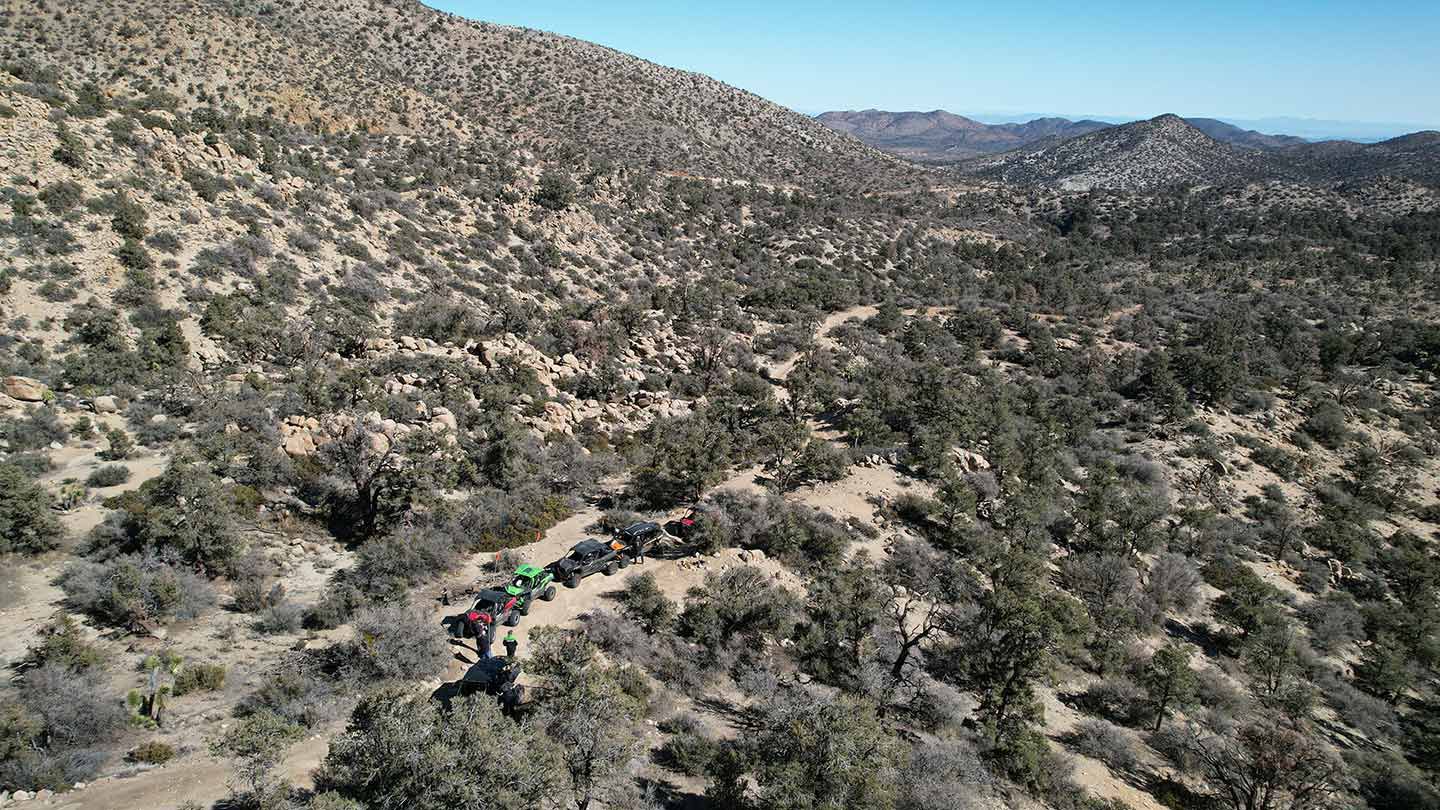
This engine is built specifically for the rigors of UTVing and features a rear layout so the powertrain is located behind and underneath us. Like the engine case, the transmission housing is beefy looking. The engine transfers power to the wheels via a centrifugal clutch and a CVT (continuously variable) automatic transmission. It’s the same type of transmission that Team Green’s used in its Brute Force ATVs and in its original Teryx that debuted for the 2008 model year. It’s a popular transmission that powersport manufacturers use in ATVs, UTVs, and scooters. The engine drinks from a 10.6-gallon fuel cell.
The benefit of a CVT is it allows the engine to operate at the rpm where it’s producing the meat of its power. It also gives the transmission a greater range in terms of speed. For example, when you accelerate from a standstill you’ve got power. Yet when you’re traveling at 60 mph, the parallel twin is not revving to the moon. Speaking of top speed, we operated this vehicle during the 2022 Kawasaki Teryx KRX 1000 Review and it is limited to 65 mph. While that top speed is plenty quick for us, realistically the new breed of ultra-high-performance sport UTVs like Polaris’ recently introduced RZR inline-four is capable of nearly 100 mph.
These Teryxes are easy to drive. You can operate like a car: with your right foot on the gas pedal, and switch for brake pedal duties. Or you can drive double-foot style in which the right foot covers the gas pedal and left, the brake. That’s what we recommend.
Instrumentation consists of a basic-looking LCD. It includes a speedometer, gear position, and fuel gauge. There’s also a tachometer readout, which is kind of silly since there are no gears to shift, nor any way to over-rev the engine. So you really don’t need an rpm gauge—but it’s there… And it’s hard to see. An engine coolant temperature meter keeps tabs on the engine’s cooling water and sits right around 172 degrees Fahrenheit. There’s also a nifty belt temperature gauge. During our ride the gauge was pegged at “low.” Kawasaki includes this readout because heat is the primary factor that causes CVT belts to fail. Oddly enough, an ambient air temperature gauge is missing.
If you’re into UTVs, you’ve likely heard horror stories about other manufacturers’ CVT transmissions and how prone they are to belt failure. Kawasaki’s done its homework, as usual, with its Brute Force ATVs and the original Teryx to ensure that this gearbox won’t leave you stranded. How do you get the CVT belt temp up? Mashing on the throttle all the time over rough terrain and doing a lot of start stops. This type of operation is hard on CVTs and generates heat. It’s worth noting that there are intake ducts to help push ambient air into the belt housing to keep it in normal operating temperature.
Generally we’re not big fans of CVT transmissions, instead preferring conventional mechanical (or DCT) gearboxes, but Kawasaki’s setup functions well. Of course, there is some annoying drone that is par for the course with a CVT, however it isn’t overwhelming. To be fair, we wear earplugs which do reduce the droning but we still notice it.
Contrary to other high-hood UTVs, the Teryx is easy to peer out of. The viewport is nice and big, and the hood slopes at a low angle so it’s easy to see ahead. There’s also three-quarter viewing ports on either side so it’s easy to check the blind spot on both sides of the vehicle. We always check the blind spot real quick when entering or crossing over a trail network.
It’s worth noting that when operating these vehicles, just because you’re on four wheels and have a steel cage doesn’t make side-by-sides any less dangerous than a motorcycle or other powersport vehicles. Always operate the vehicle within your limits, wear the appropriate safety gear, and keep limbs inside the vehicle. Keep your eyes on the trail ahead. If everyone respects one another regardless if you’re on a motorcycle or UTV, everything will be that much better for all. Be respectful and operate the vehicle within your limits. If you want to improve your ability, seek professional training.
A sturdy steel roll cage helps protect occupants in the event of a rollover. When you expect a rollover it’s always critical to keep your limbs inside the cockpit. If you sense the vehicle is going to roll, firmly grab the steering wheel and do not let go. The passenger should grasp the grab handle as well. When Yamaha first introduced its original side-by-side decades ago, there were a lot of people getting injured due to rollovers. Always wear the safety belt and a full-face helmet. We prefer dual-sport-style helmets because they include a traditional visor. And unlike an off-road helmet with goggles, the interior is sealed so there’s no dirt or dust. It’s also quiet and you don’t have air moving over your face.
The Teryx offers push-button four-wheel drive that can be used at any vehicle speed. It takes some of the worry out of driving with reduced vehicle slip. Two-wheel drive (with locked rear differential) allows for added fun by doing slides and drifting but you can still get sideways in four-wheel drive. Of course it’s a tad more difficult because the KRX is more hooked up. It also comes outfitted with a selectable locking front differential allowing for true four-wheel drive. This is ideal for rock crawling or navigating very precarious terrain. With the differential locked, steering is a tad heavier, but only marginally, and not enough to adversely affect steering effort.
Railing ruts is a different sensation in the KRX versus a dirt bike. But it’s fun, especially in four-wheel drive, where one can feel those 31-inch front meats dig in and help it pull the vehicle out of soft dirt. It also makes for some tasty deep ruts when fellow drivers keep their wheels on track and power out in four-wheel drive.
Kawasaki prides itself with visceral powertrain sound from its Ninja sportbikes and KX motocross bikes. Even its supercharged Ultra 310 Jet Ski sounds wicked. Oddly enough, you don’t hear too much character out of this engine configuration. It would be nice if it had added visceral excitement. We do value how smooth the powerband is, but it’s almost too smooth. Sometimes when you’re driving these off-road vehicles you want the powerband to have some hit so you can motor out of soft terrain. If you’re a power-hungry person who desires more oomph that’s going to put you back in the bucket seat, this vehicle isn’t it. It’s worth noting multitime motocross and Supercross champ and the King of Supercross, Jeremy McGrath, Kawasaki’s official US ambassador, has a KRX 1000 outfitted with an aftermarket turbocharger. So there are aftermarket solutions to literally boost the power output of this liter-sized twin.
In terms of engine vibration, there isn’t a whole lot of it to be felt through the seat or controls.
This KRX 1000 employs advanced suspension. Double-wishbone suspension up front (18.6 inches of travel) and four-link-style rear suspension (21.1 inches of travel). For reference, a motocross bike is right around 12 inches of travel fore and aft. So these vehicles have nearly double the travel of an off-road motorcycle. The suspenders offer a comfortable ride, yet provide a pleasing level of support over the rough stuff. Each shock offers spring preload and compression damping adjustment. So if you have good mechanical aptitude and vehicle handling skills, you can tailor the action of the shocks based on driving preference or application.
Even though the KRX is more sporty than the existing V-twin-powered Teryx 800, there’s still a degree of utility built into it. If you want to tow some Jet Skis or run around the farm to do work and still have a bit of fun, you can do it with the KRX 1000. It aligns with the person who desires a sporty UTV but doesn’t want to give up utility functionality.
Storage-wise, in lieu of the accessory TFT dash, there’s an empty box in which you could install a radio, etc. There’s also a glove box–style compartment. In terms of creature comforts there are a pair of cupholders and one 12-volt power socket. The front bumper also benefits from auxiliary wiring, so if you get a winch, it’s easy to connect it to a power source.
To park this vehicle, since there’s no parking mode like a traditional car, you leave it in “H” and apply the cable-actuated parking brake lever.
This vehicle rolls on 31-inch beadlock eight-ply Maxxis tires mounted on 15-inch cast aluminum wheels. Not only are the wheels functional but they look cool too. For some, a popular accessory for the KRX will be a windshield. We generally, at least in Southern California, don’t need a windshield—as all it’s going to do is get hard to see with dust, and the weather is fairly temperate here. But if you’re somewhere where it’s cold and it rains a lot, snows a lot, having a windshield is a handy accessory.
Strong linked four-wheel hydraulic disc brakes (with stainless steel brake lines) keep speed in check. The front brakes employ twin-piston calipers, while the rears use single-piston brake calipers. The brakes offer adequate response. They’re not as sharp as a modern automobile but they’re not as spongy as they used to be on Teryxes of old. Because this is a non-street-legal off-road vehicle there is no ABS. If you press hard enough on the brake pedal, the brakes will lock up.
This Teryx KRX 1000 measures 68 inches in terms of width. That splits the difference between the modern ultra-high-performance sport UTV class (72 inches) and the original ATV-trail-friendly Teryx 800 (62 inches). The extra width enhances stability and helps mitigate rollover, yet doesn’t make the vehicle overly cumbersome on trails. Still, it’s worth noting that the KRX 1000 won’t be as maneuverable through narrow forest trails as its 800 sibling.
Maintenance-wise, after initial break-in service (20 hours or 600 miles) the KRX requires engine oil changes every 100 hours or each six months. Engine oil filters need to be made once a year. Realistically, considering how easy it is to access the engine oil filter, if it’s our vehicle, we would replace the filter at every oil service. Valve inspection intervals are every 200 hours. Kawasaki also recommends replacing the transmission oil and the differential oil annually. And a whopping 400 hours is recommended for fuel filter swaps.
Of course because you’re operating these vehicles usually in very dusty environments it’s always good to pay attention to the air filter. Make sure that thing isn’t clogged. Kawasaki recommends inspection every 50 hours.
A fun fact about these Teryx KRX 1000s is that they are assembled in Lincoln, Nebraska. The Green Team has operated US manufacturing in Lincoln since the ‘70s. So for more than 40 years Kawasaki has been manufacturing many of its ATVs, Jet Skis, and UTVs at its Nebraska factory. Kawasaki also builds cars for the New York subway. So when it comes to manufacturing, Kawasaki sets itself apart from the competition. Overall build quality is above average for a UTV. It’s not going to be as well put together as a Ninja ZX-10R but for $23,200 it’s pretty good. Kawasaki stands behind its product with a six-month warranty. It also offers extended warranty plans for riders seeking extra protection from mishaps.
Outdoor enthusiasts seeking added comfort, convenience, and ease of use, as compared to an adventure or dirt bike, plus the ability for a non-riding friend to tag along will naturally appreciate Kawasaki’s 2023 Teryx KRX 1000 sport UTV. It’s really easy to drive; has nice smooth power; rides and drives well; and has suspension that gobbles up rough stuff and delivers you to where you want to be in a comfortable way. Sure, it’s not the fastest sport UTV out there, but the performance is enough to put a smile on your face. In the end, that’s what these things are about: bringing you and your favorite person out into Mother Nature. For being a modern motorcyclist, a sport UTV like Kawasaki’s Teryx works into our powersport portfolio.
Gear Box
Helmet: Shoei Hornet X2
Boots: TCX Rush 2 Air
2023 Kawasaki Teryx KRX 1000 Technical Specifications and Price
| PRICE | $23,199 |
|---|---|
| ENGINE | 999cc, DOHC, liquid-cooled parallel twin; 8-valve |
| BORE x STROKE | 92.0 x 75.1mm |
| COMPRESSION RATIO | 11.5:1 |
| CLAIMED TORQUE | 76.7 lb.-ft. @ 7,000 rpm |
| FUEL DELIVERY | Digital fuel injection w/ dual 50mm throttle bodies |
| CLUTCH | Centrifugal |
| TRANSMISSION | Automatic CVT w/ high/low range, reverse |
| FINAL DRIVE | Selectable 2WD/4WD w/ locking front differential, shaft |
| FRAME | Ladder-type tubular steel |
| FRONT SUSPENSION | Double wishbone, Fox 2.5 Podium LSC shocks, spring preload, 24-position compression damping adjustable; 18.6 in. travel |
| REAR SUSPENSION | 4-link trailing arm, Fox 2.5 Podium LSC shocks, spring preload, 24-position compression damping adjustable; 21.1 in. travel |
| FRONT BRAKE | 2-piston calipers, dual hydraulic discs |
| REAR BRAKES | 1-piston caliper, dual hydraulic discs |
| WHEELS | Alloy w/ beadlocks; 15 in. |
| TIRES, FRONT/REAR | Maxxis Carnivore; 31/10-15 |
| GROUND CLEARANCE | 14.8 in. max./14.2 in. standard |
| WHEELBASE | 98.8 in. |
| OVERALL WIDTH | 68.1 in. |
| FUEL CAPACITY | 10.6 gal. |
| CLAIMED CURB WEIGHT | 1,896 lb. |
| WARRANTY | 6 months |
| AVAILABLE | January 2022 |
| CONTACT | kawasaki.com |
Source: MotorCyclistOnline.com
